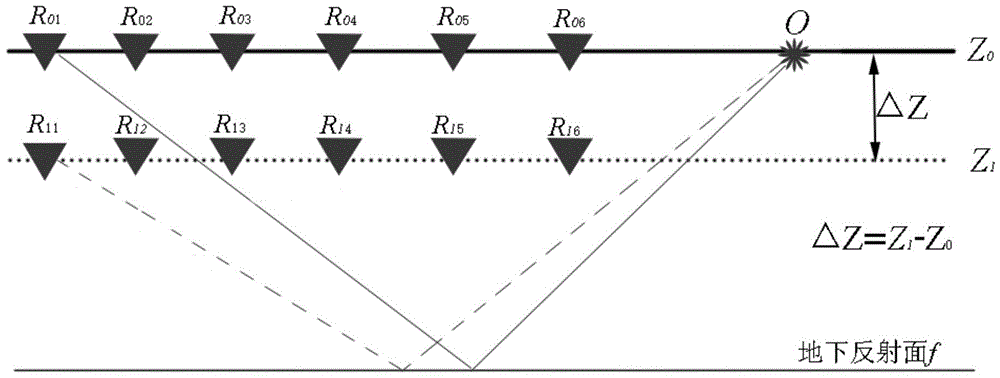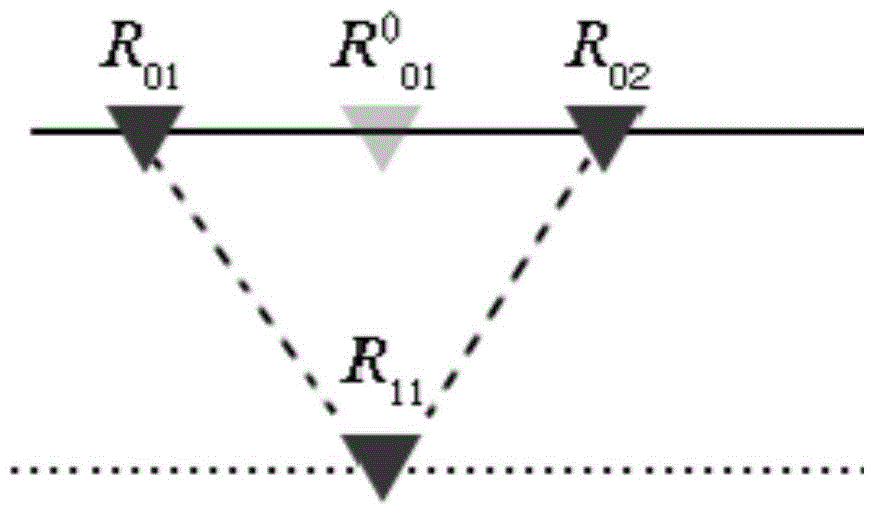True amplitude migration imaging method
A technology of migration imaging and true amplitude, applied in seismic signal recording, seismic signal processing, etc., can solve problems such as accurately solving acoustic wave equations, increasing the reliability of geological interpretation and seismic inversion analysis, etc.
- Summary
- Abstract
- Description
- Claims
- Application Information
AI Technical Summary
Problems solved by technology
Method used
Image
Examples
Embodiment 1
[0081] Example 1 Steep Angle Inclined Interface Model
[0082] As shown in Fig. 4, in order to study and compare three migration algorithms: Kirchhoff prestack depth migration method, dual detector prestack depth migration method and prestack depth reverse time migration method, the lithology Ability to recognize changes. Among them, the velocity model is shown in Figure 4(a).
[0083] The specific operation is as follows:
[0084] (1) A detector layer is arranged at a certain depth on the surface and underground, and multiple detector points are arranged on each layer. The detectors on the upper and lower layers are vertically corresponding, and the depth of the underground detector layer is a continuation step;
[0085] (2) The geophones of the same geophone layer are horizontally connected and a large line is responsible for transmitting the collected seismic signal data; the seismic signal data of each geophone point is collected;
[0086] (3) The geophones on the upper...
Embodiment 2
[0092] Example 2: Double layer interface model
[0093] As shown in Fig. 5, three migration algorithms are studied: Kirchhoff pre-stack depth migration method, dual detector pre-stack depth migration method and pre-stack depth reverse time migration method, under the influence of floating strata The ability to identify lithology of the underlying strata. The velocity model is shown in Fig. 5(a).
[0094] The specific operation is as follows:
[0095] (1) A detector layer is arranged at a certain depth on the surface and underground, and multiple detector points are arranged on each layer, and the detectors on the upper and lower layers correspond vertically; the depth of the detector layer underground is a continuation step;
[0096] (2) The geophones of the same geophone layer are horizontally connected and a large line is responsible for transmitting the collected seismic signal data; the seismic signal data of each geophone point is collected;
[0097] (3) The geophones on...
Embodiment 3
[0103] Example 3: Multiple Interface Models
[0104] like Image 6 , is to study three migration algorithms: Kirchhoff pre-stack depth migration method, dual-detector pre-stack depth migration method and pre-stack depth reverse-time migration method, the imaging ability and lithology identification ability of complex models .
[0105] The specific operation is as follows:
[0106] (1) A detector layer is arranged at a certain depth on the surface and underground, and multiple detector points are arranged on each layer, and the detectors on the upper and lower layers correspond vertically; the depth of the detector layer underground is a continuation step;
[0107] (2) The geophones of the same geophone layer are horizontally connected and a large line is responsible for transmitting the collected seismic signal data; the seismic signal data of each geophone point is collected;
[0108] (3) The geophones on the upper and lower floors are vertically aligned, and the necessary...
PUM
 Login to View More
Login to View More Abstract
Description
Claims
Application Information
 Login to View More
Login to View More - R&D
- Intellectual Property
- Life Sciences
- Materials
- Tech Scout
- Unparalleled Data Quality
- Higher Quality Content
- 60% Fewer Hallucinations
Browse by: Latest US Patents, China's latest patents, Technical Efficacy Thesaurus, Application Domain, Technology Topic, Popular Technical Reports.
© 2025 PatSnap. All rights reserved.Legal|Privacy policy|Modern Slavery Act Transparency Statement|Sitemap|About US| Contact US: help@patsnap.com



